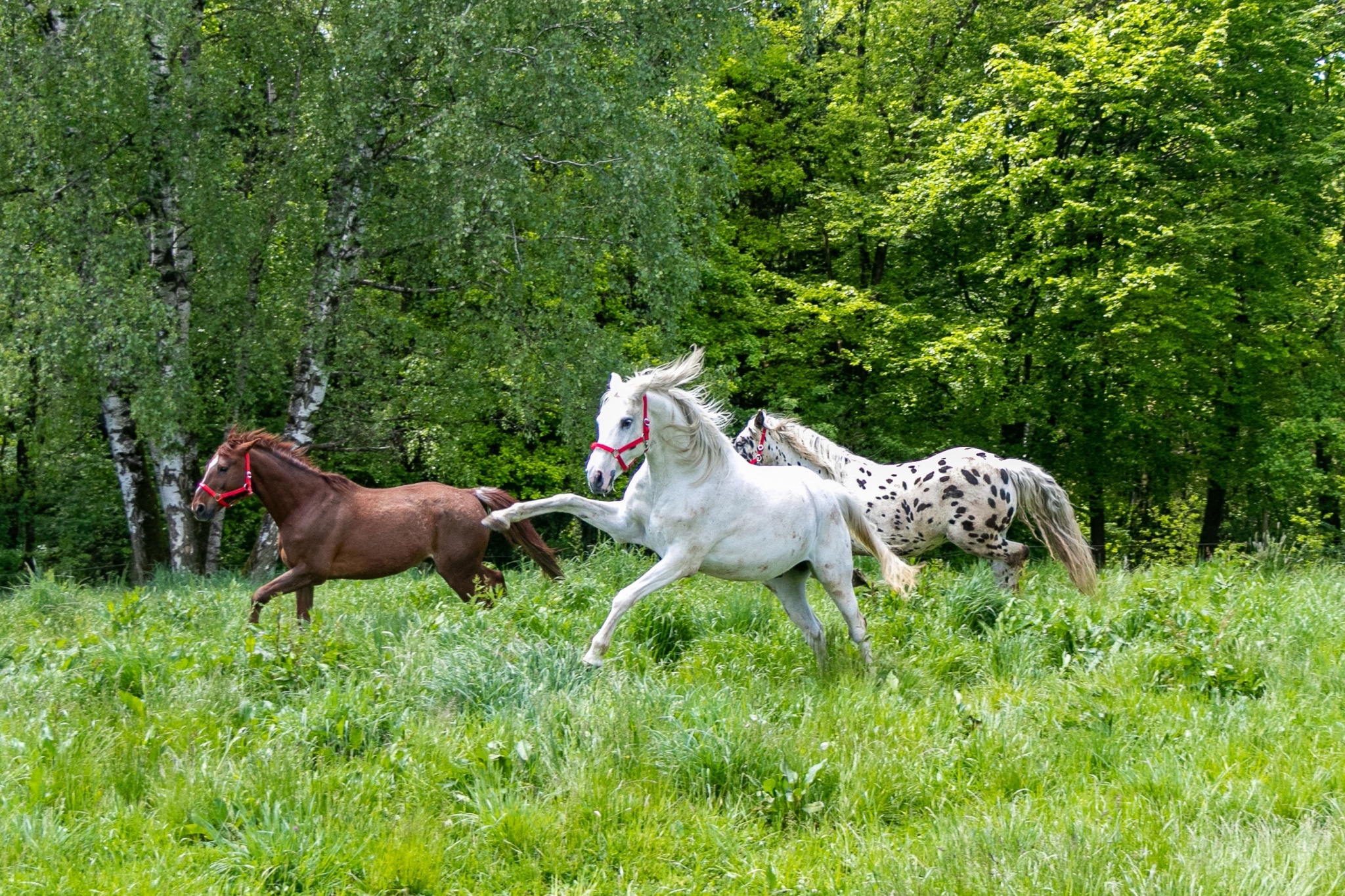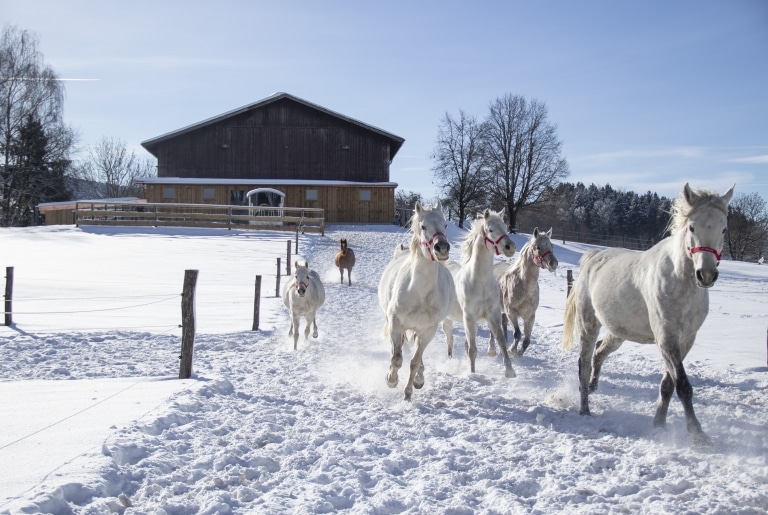
Horse husbandry
A key role in improving quality of life
Horse husbandry plays a key role in improving the quality of life of old horses. There is still not enough knowledge about feeding old horses according to their needs. This makes it all the more important to create a healthy ecosystem between grassland and grazing animals in order to permanently improve the well-being of old horses.
Basis/starting point: Modern forms of horse husbandry are characterised by the fact that the animals are motivated to exercise constantly by spatially separating areas into different functional areas. The so-called paddock trails are outdoor horse facilities that implement the aforementioned principle in a particularly consistent manner; recreational areas such as the lounging hut, watering hole and feed trough are located at a distance from each other and connected by walkways. The natural movement pattern of the animals achieved in this way promotes their health and harmonious coexistence within groups of horses.
To protect the sward and for reasons of animal health and safety, these paths must be surfaced if the paddock trail is to be used all year round. However, this is contrary to the interests of protecting cultivated land. In Switzerland, for example, cantonal spatial planning authorities grant no or only limited authorisations for paddock trails with all-weather paved walkways in the agricultural zone.

Objective: In order to resolve this conflict of objectives between animal welfare and the protection of cultivated land, this project aims to develop solutions for soil-friendly trail and runway fortifications that fulfil both animal welfare and spatial planning interests (no permanent impairment of valuable cultivated land, in particular crop rotation areas in Switzerland). To this end, the effectiveness of selected attachment options will be analysed, taking into account animal welfare, vegetation and impact intensity. In particular, the regeneration and recultivation of the soil after two years of exposure to the animals will be monitored.
In addition, a cross-sectional study with snapshots of soils from various existing practical farms with paddock trails is being carried out as a side project in order to record the effects of the load with different fastening materials and management measures.
New findings: The sub-project “Cross-sectional study with snapshots of soils of various existing practical farms” has already taken place. The running surfaces of 17 farms from Switzerland, Germany and Luxembourg were sampled: 135 samples from a depth of 0-20 cm for the investigation of microbial biomass, 405 samples from a depth of 10, 20 and 30 cm for the recording of compaction and 33 samples from a depth of 10 cm for the determination of microplastics in the soil. The laboratory analyses are ongoing.
Outlook: The structural measures (installation of walkways, pasture shelters, feed troughs and drinking troughs, fencing) are planned on an ongoing basis as soon as the building permit has been granted. It should be possible to move the 20 test horses and thus start systematically loading the ground reinforcement from August 2022, depending on the weather conditions.
Project management: The project is an interdisciplinary collaboration between the soil specialists Agroscope-Reckenholz (Dr Thomas Keller group), the horse husbandry specialists Agroscope-Avenches (Dr Iris Bachmann group) and the Department of Environmental Sciences ETH Zurich (Prof. Dr Sebastian Dötterl group).
Many horses suffer from welfare diseases on modern grasslands. These grasslands originate mainly from cattle farming. They are too rich in energy and protein for horses. They are by no means steppe grasses. In addition, scientists are increasingly recognising that the ancestors of our horses did not only come from the steppe, but mainly populated the savannahs created by large herbivores. The small-scale mosaic of vegetation in savannahs offers not only wild grasses but also many medicinal herbs, protection from the weather under trees and mineral-rich supplementary feed from the leaves of bushes. The projects at Gut Aiderbichl record the current condition and characteristics of the areas, derive their possible potential from this and look for ways to create a near-natural, species-rich forage area for the benefit of the existing horses.
Biodiversity and toxic endophytes in meadows and pastures
- A basis for linking species protection and animal welfare
- Recognising potential threats and potential for improvement
Basis/starting point: Gut Aiderbichl has the declared aim of promoting not only animal welfare, but also species conservation.
Microscopic fungi that live symbiotically in plant tissue – so-called “endophytes” – often take meadow grasses as their host. They make the plants more robust and productive, but can damage the health of grazing animals in the long term; horses are particularly sensitive to the toxins (poisons) produced. The activity and effects of endophytes on grazing animals depend on various ecological factors, which also influence the diversity of species in meadows and pastures. Such habitats have suffered major losses in biodiversity over the last century, mainly due to intensification, in particular over-fertilisation and overgrazing.
While the problem of toxic endophytes has long been known and intensively studied overseas (especially in North America and New Zealand), it has long received little attention in Europe. In addition, the ecological significance of these associations is still unclear.
With this in mind, an international study was launched to provide a database on the effects of toxic grass endophytes on grazing animals and to analyse the biodiversity of the Gut Aiderbichl areas.
Objectives: At various Gut Aiderbichl sites in Germany, Austria, France and Hungary, meadows and pastures will be studied in terms of vegetation ecology and plant samples will be collected for toxicological laboratory analyses. The project is thus intended to provide an insight into the botanical species composition, ecological site conditions and occurrence of toxic endophytes in the analysed sites. In this way, the ecological potential of the meadows and pastures used can be realised in the future, while at the same time ensuring a diet adapted to the needs of the animals.
Results: Valuable insights have already been gained from the initial work in 2021:
Species characterised by frequent symbiosis with toxic endophytes were observed in almost all recording areas, and on average amounted to around a third of the total vegetation cover. The presence of toxic endophytes was confirmed by laboratory analyses at two sites in Austria and France, with red fescue and perennial ryegrass as hosts. Furthermore, the frequency of plants toxic to horses (e.g. ground ivy and buttercup) could be quantified on the investigated sites and particularly problematic areas identified.
On average, the survey areas at all the sites investigated so far were species-poor, presumably due to intensive utilisation. However, certain natural values are present, as evidenced by the occurrence of isolated endangered or potentially endangered species as well as above-average numbers of species on horse pastures. This study therefore provides a basis for designing measures to protect and enhance the meadows and pastures on the Gut Aiderbichl land.
Outlook: The project will be continued in 2022, focussing on pastures of varying ecological quality. This investigation should complement an ongoing study on the nutritional value of the hay obtained. Furthermore, ecological enhancement measures at Gut Aiderbichl France will be planned on the basis of the findings obtained in 2021, which will provide for long-term impact monitoring.
Publications: Seiler, H. & Dengler, J. 2022. Vegetation study of grasslands in Europe to quantify the problem of toxic vascular plants and toxic endophytic fungi for grazing animals, especially horses. ZHAW, Wädenswil
Project management: Research group Vegetation Ecology (Prof Jürgen Dengler) at the Zurich University of Applied Sciences (ZHAW)
Promoting biodiversity on horse pastures - Herb-rich agroforestry pastures for older horses
Basis/starting point: Climate change and the loss of species diversity and biodiversity of our pastures, as a result of intensification, are a reality in agriculture. Horse owners are not exempt from this, and solutions that take these facts into account are greatly appreciated. Gut Aiderbichl, which manages many farms and pastures, has decided to tackle this problem in a multidisciplinary project. In addition, many pastures today are shadeless and this poses a problem for horses, especially with the increasing global warming, because they need shade to protect themselves from the sun, insects and heat. However, not all tree species are equally suitable for providing shade as an agroforestry element on horse pastures.
This project was launched in spring 2021 with an analysis and compilation of plant species and trees that are suitable for horse pastures, increase native biodiversity in agricultural areas and should also be as resilient as possible to weather fluctuations caused by climate change.
Aim: Two different, species-rich horse pasture seed mixtures were specially developed with the aim of combining biodiversity promotion with a species-appropriate diet for older horses. A mixture for drier conditions and a mixture for wetter conditions were created for this purpose. The combination of these two mixtures will also serve for the frequently fluctuating weather conditions in climate change. This study will also deal with the possibilities of shading pastures with native tree species in a theoretical part.
New findings: These pasture seed mixtures were sown on a trial field in summer 2021. An initial botanical analysis in May 2022 revealed a similarly high species diversity for both mixtures, but a twice as high proportion of herbs in the dry mixture compared to the moist mixture. A second botanical analysis will now be carried out in August 2022, the pastures will be mown and quality parameters noted. In a feeding trial, the pasture will be grazed and/or hay will be fed to horses to investigate potential preferences of horses for the different plant mixtures.
Outlook: First results are expected in December 2022 and will be published here. A recording in spring 2023 should provide information on whether the pasture seed mixtures used have established themselves stably and are appreciated by the horses.
Project management: Sandgrueb Foundation